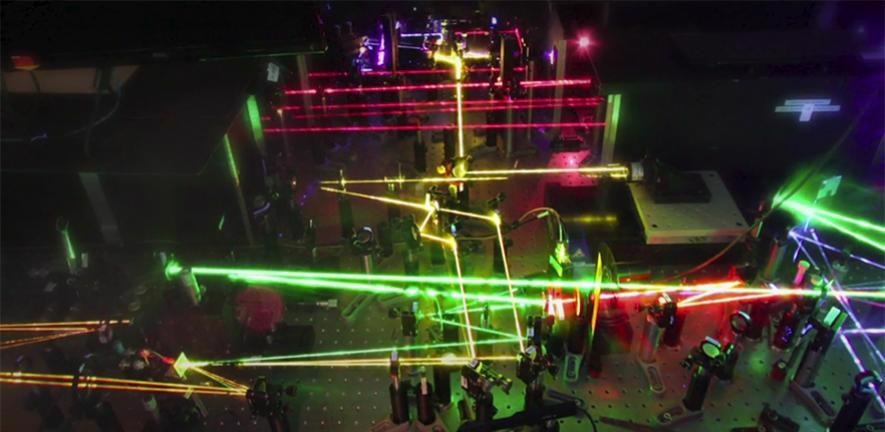Scientists, guided by the University of Cambridge, discovered a loss pathway in organic solar cells which renders their efficiency lower than silicon-based cells when it comes to turning sunlight into electricity.
 Lasers in the Optoelectronics Lab. Image Credit: Akshay Rao.
Lasers in the Optoelectronics Lab. Image Credit: Akshay Rao.
Furthermore, they found a way to overpower this pathway by influencing molecules inside the solar cell to stop electrical current loss via an unwanted state, called a triplet exciton.
Their findings, reported in the Nature journal, propose that it is possible for organic solar cells to contend more closely with silicon-based cells for efficiency.
Organic solar cells, which are semi-transparent, flexible and inexpensive, can significantly widen the number of applications for solar technology. They could be fixed around the outer surfaces of buildings and can be used to efficiently recycle the energy used for indoor lighting. Both of these are not possible with currently available silicon panels. They are also far more eco-friendly to manufacture.
Organic solar cells can do lots of things that inorganic solar cells can’t, but their commercial development has plateaued in recent years, in part due to their inferior efficiency. A typical silicon-based solar cell can reach efficiencies as high as 20 to 25%, while organic solar cells can reach efficiencies of around 19% under laboratory conditions, and real-world efficiencies of about 10 to 12%.
Dr. Alexander Gillett, Study First Author, Cavendish Laboratory, University of Cambridge
Organic solar cells produce electricity by roughly imitating the natural process of plant photosynthesis, except that they, in due course, use the energy of the sun to form electricity rather than turn water and carbon dioxide into glucose.
When a light particle (photon) hits a solar cell, an electron is stimulated by the light, leaving behind a “hole” in the electronic structure of the material. The excited electron and hole combination is called an exciton.
If the common attraction between the positively charged hole and the negatively charged electron in the exciton, similar to the attraction between the positive and negative poles of a magnet, can be surpassed, these electrons and holes could perhaps be harvested as an electrical current.
However, electrons in solar cells tend to be lost during a process known as recombination. The energy — or excitation state — of the electrons is lost and they fall back into the empty hole state. As there is a robust attraction between the electron and hole in carbon-based materials compared to silicon, organic solar cells are more susceptible to recombination, which in turn impacts their efficiency.
This dictates the use of two components — an electron “donor” material and an electron “acceptor” material — to prevent the electron and hole from recombining quickly.
Combining computer modeling and spectroscopy, the scientists could track the underlying mechanisms in organic solar cells, from photon absorption to recombination. They learned that a critical loss mechanism in organic solar cells was due to recombination to a specific type of exciton, called a triplet exciton.
In organic solar cells, triplet excitons create a challenging problem to surpass, as it is energetically advantageous for them to develop from the electrons and holes. The scientists discovered that by causing the electron donor and electron acceptor materials to have robust molecular interactions, the electron and hole could be kept further apart, thereby preventing recombination into triplet excitons from happening.
Computational modeling recommends that by modifying the parts of the organic solar cells in this way, the timescales of recombination to these triplet exciton states could be minimized by an order of magnitude, facilitating more efficient solar cell function.
The fact that we can use the interactions between components in a solar cell to turn off the triplet exciton loss pathway was really surprising. Our method shows how you can manipulate molecules to stop recombination from happening.
Dr. Alexander Gillett, Study First Author, Cavendish Laboratory, University of Cambridge
Now, synthetic chemists can design the next generation of donor and acceptor materials with strong molecular interactions to suppress this loss pathway,” said co-author Dr. Thuc-Quyen Nguyen from the University of California, Santa Barbara. “The work shows the path forward to achieve higher device efficiency.”
The scientists say their technique delivers a strong strategy to attain organic solar cells with efficiencies ranging from 20% or more by preventing recombination into triplet exciton states. As part of their research efforts, the team was also able to formulate design rules for the electron donor and electron acceptor materials to achieve this goal.
They trust that these strategies will enable chemistry groups to create new materials, which would stop recombination into triplet excitons, allowing the creation of organic solar cells with efficiencies close to silicon to be achieved.
Journal Reference:
Gillett, A. J., et al. (2021) The role of charge recombination to triplet excitons in organic solar cells. Nature. doi.org/10.1038/s41586-021-03840-5.